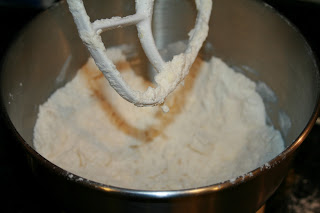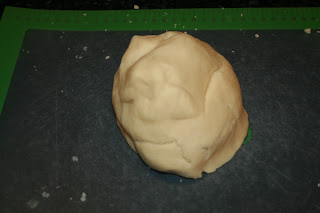American cheesecake is dense - brick-like. You could probably hurt someone by hitting them with a New York style cheesecake. It's also rich; I don't even want to know how many calories are in a slice of American cheesecake.
German cheesecake is light and fluffy. It's got a crust that's to die for and a creamy melt-on your tongue filling. It's great stuff - and almost low cal. (OK, that last one may be an exaggeration, but it's good stuff, if I may say so myself.)
Unfortunately, as many German cheesecake lovers discover when they get to the States, one of the necessary ingredients is not available for purchase in many parts of the United States. Making cheesecake requires "quark" - a white cheese that has the consistency of sour cream, but the flavor of a cottage cheese or ricotta. Here in Kentucky, I can purchase quark in Cincinnati at Jungle Jim's for about $7 per 1/2 lb or so. If I ignore the cost of the road trip to Cincinnati, that amounts to a $30 cheesecake, and that's just a bit much for an everyday cheesecake.
People have come up with rather ingenious mixtures to try to replace quark in recipes. Some people mix 9 parts ricotta with 1 part sour cream; others make their own quark from buttermilk (since raw milk is not available for purchase). A friend suggested putting cottage cheese in a blender and pushing the mixture through a colander, but that just sounds like a pain in the rear.
My mother, the master baker, when faced with the problem, told me:"Just substitute the quark with sour cream and put an extra egg in the mixture. It's going to be OK." So that's what I tried and the result is a regular fluffy German cheesecake. It certainly doesn't taste like there's anything missing....
But on to the cheesecake: There are 2 parts to that recipe - the crust and the filling. German cheesecake has a Mürbteig crust rather than a graham cracker crust. This dough is sometimes called 1-2-3 dough, because the ingredients are 1 part (by weight) sugar, 2 parts butter and 3 parts flour. The dough can be used as a stand-alone dough to make cookies or it can make a crust for cheesecake, for example.
 The recipe below is for a 12-inch spring form cake pan. You need 300g All-purpose flour, 200g butter, 100g sugar, a dash vanilla extract, zest from 1/4 lemon (optional), 1 dash salt and 1 egg yolk.
The recipe below is for a 12-inch spring form cake pan. You need 300g All-purpose flour, 200g butter, 100g sugar, a dash vanilla extract, zest from 1/4 lemon (optional), 1 dash salt and 1 egg yolk.
Traditionally, the 1-2-3 dough is made using a mound of flour and adding the rest of the ingredients into an indention in the flour. I like to start the mixing process with my trusted Kitchenaid mixer.
But on to the cheesecake: There are 2 parts to that recipe - the crust and the filling. German cheesecake has a Mürbteig crust rather than a graham cracker crust. This dough is sometimes called 1-2-3 dough, because the ingredients are 1 part (by weight) sugar, 2 parts butter and 3 parts flour. The dough can be used as a stand-alone dough to make cookies or it can make a crust for cheesecake, for example.
 The recipe below is for a 12-inch spring form cake pan. You need 300g All-purpose flour, 200g butter, 100g sugar, a dash vanilla extract, zest from 1/4 lemon (optional), 1 dash salt and 1 egg yolk.
The recipe below is for a 12-inch spring form cake pan. You need 300g All-purpose flour, 200g butter, 100g sugar, a dash vanilla extract, zest from 1/4 lemon (optional), 1 dash salt and 1 egg yolk.Traditionally, the 1-2-3 dough is made using a mound of flour and adding the rest of the ingredients into an indention in the flour. I like to start the mixing process with my trusted Kitchenaid mixer.
Once everything is evenly distributed in the mixture, I start working on it by hand - kneading it to incorporate more and more of the streusel.
Eventually, the dough will become firm and smooth. It should only be worked until the butter is incorporated. Most people suggest that the dough needs to rest for 2 hours to overnight in the fridge before it can be used. At minimum, I wrap it in cling wrap and put it in the fridge while I work on the filling mixture.
For the filling I use 1000g sour cream, 7 eggs, a package of Dr. Oetker vanilla pudding, 200g sugar, 100 g butter, 1/2 tsp vanilla extract, zest of 1/2 lemon (optional), 1 tablespoon milk
Start by separating the egg whites, add them to a very clean mixing bowl and beat them with the mixer until stiff peaks form. Set the egg foam aside. Scramble the yolks and mix the rest of the ingredients with them. I usually add the melted butter last. Then gently fold the egg yolk pudding mix into the egg foam. (The vanilla pudding powder is added as a powder, not as a prepared pudding!)
Grease a 12-inch springform and make the crust. It's possible to roll the dough, but I often just press the dough into the form piece by piece. The crust should cover the bottom and the sides of the form. Then add the filling to the form, taking care not to overfill the form. The filling will rise above the form during baking.
The cake is done when a toothpick inserted in the center comes out clean. After the cake has finished baking, the most difficult part is (1) getting the cake out of the spring form and (2) keeping the cheesecake from cracking. In my experience, cracks on the edge happen during baking and are almost unavoidable. When the cheesecake cools, those cracks become essentially invisible.
Cracks in the middle of the cake are a function of movement and cooling. Many people suggest to leave the cake in the oven after it's done baking. Cooling the cake down slowly will minimize the cracking across the middle.
To ease removal of the cake from the form, some people line the form with baking paper, other suggest sliding a knife along the wall of the form about 15 minutes into the baking process.
Many German bakers will place the cheese cake upside down on a cooling rack to create a circular pattern on the top of the cake. I have not had the nerve to actually turn this cake upside down. I have, however, found that a large crack in the middle of the cheesecake can be easily covered with chocolate frosting.
At any rate, here is what this what German cheesecake looks like when it is minimally cracked on the top.
Recipe:
Käsekuchen (German cheesecake)
For the crust:
300g All-purpose flour
200g butter
100g sugar
dash vanilla extract
zest from 1/4 lemon (optional)
1 dash salt
1 egg yolk
For the filling:
1000g sour cream
7 eggs
Dr. Oetker vanilla pudding
200g sugar
100 g butter
1/2 tsp vanilla extract
zest from 1/2 lemon (optional)
1 tablespoon milk
Click for PDF of cheesecake recipe





No comments:
Post a Comment